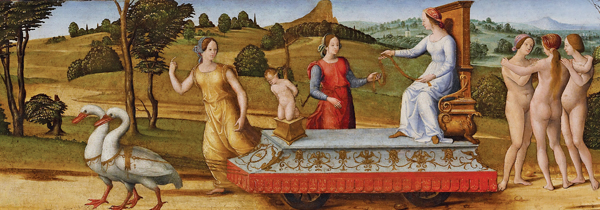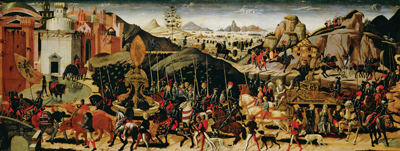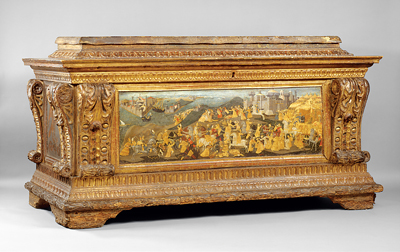|
|

Scenes from a Marriage
Bridal-chest paintings gathered by a Tufts art historian offer glimpses of wedded life in the Italian Renaissance
By Cristelle Baskins, Department of Art and Art History
When a modern bride-to-be plans her wedding, she registers at Crate & Barrel and awaits a flood of Hallmark cards. In fifteenth-century Italy, they did things a little differently. The well-to-do bride could expect to receive an elaborately decorated wedding chest known as a cassone in which to store her trousseau—her personal linens, sheets, towels, jewelry, and perhaps a few devotional books. (“Hope chests” once served the same purpose in the modern era.) Cassoni were usually commissioned in pairs and carried in bridal processions before being placed in the bedrooms of newlywed couples.
The chests were luxury goods in their own right—a form of conspicuous consumption not unlike that indulged in by some latter-day bridezillas. Their rich gold surfaces and colorful paintings were produced by artists in specialized workshops, particularly in Florence and Siena. Cassoni paintings were intended to delight as well as to inform. They featured allegorical and historical subjects, themes related to the ideals of Renaissance marriage. The paintings dramatize conflicts between duty and desire—a chastened Cupid is a reccurring character—and instruct the young (usually teenaged) bride in marital conduct.
Over centuries of use, marriage chests became worn and damaged. The paintings on the front and sides were often removed and sold to art collectors. Today they are displayed on the walls of art galleries and museums, often without reference to their original function as furniture.
An exhibition called “The Triumph of Marriage,” which I am curating at Boston’s Isabella Stewart Gardner Museum along with Alan Chong, the museum’s curator of collections, brings together cassoni paintings from around the country. Ironically, this exhibition comes at a time of uncertainty for marriage: it is increasingly short-lived, yet it has recently been opened to new groups in some countries and states. Looking back more than 600 years, we rediscover imagery from an age in which marriage was more clearly defined—rigid in its gender roles and, for the woman approaching childbirth, possibly lethal.
“The Triumph of Marriage: Painted Cassoni of the Renaissance” continues at the Isabella Stewart Gardner Museum (Boston) through January 18, 2009. It will be on view at the John and Mable Ringling Museum of Art (Sarasota, Florida) February 14–May 17.
 |
 |
 |
 |

Anonymous painter called Pseudo Granacci, Triumph of Venus, c. 1500, Walters Art Museum, Baltimore. Venus, the goddess of love, here champions good marital conduct. She has captured naughty Cupid and restrains him with her belt. Venus also prepares the way for the Three Graces—representing beauty, mirth, and creativity—shown nude at right. The frequent depiction of restraint, mature guidance, and good feminine behavior was a response to the age disparity common in Renaissance marriages. Thirty-year-old grooms entered into quasi-parental relationships with teen brides whose capacity for virtue was considered dubious. |
 |
 |
 |
 |

Francesco Pesellino (1422–1457), Triumphs of Love, Chastity, and Death, c. 1450, Isabella Stewart Gardner Museum, Boston. Francis Petrarch’s poem cycle The Triumphs, c. 1370, provides the subject matter for this chest. Earthly life is represented allegorically as a battle between desire, represented by Cupid standing on a chariot to the left, and virtue, personified by Chastity toward the right. The grim figure of Death enters at the right, riding on a hearse drawn by oxen and trampling corpses. Renaissance brides understood the connection between desire and death very well. In fact, Florentine women often made out their wills in the late stage of pregnancy when mortality seemed imminent. The lucky women who survived the ordeal of childbirth might go on to produce a dozen children. In the detail above, the depiction of Chastity on her chariot surrounded by beautiful maidens mirrors the festive procession that ushered the Florentine bride from her father’s home to that of her new husband. |
 |
 |
 |
 |

Pesellino shop, Liberal Arts, Birmingham Museum of Art, Birmingham,
Alabama. The seven liberal arts—arithmetic, geometry, music, astronomy,
logic, rhetoric, and grammar—made
up the Trivium and the Quadrivium of the premodern curriculum. |
 |
 |
 |
 |

Pesellino shop, Seven Virtues, Birmingham Museum of
Art, Birmingham, Alabama. In the depiction
of the seven virtues—Prudence, Justice, Faith, Charity, Hope,
Fortitude, and Temperance—the female personifications appear in
large scale, seated in triumph like secular rulers, with their
male exemplars positioned below. Five of the seven male figures
hold books, marking them as authors, scholars, or worthies. Only
men would have access to formal higher education. |
 |
 |
 |
 |

Biagio d’Antonio (1446–1516) and shop, Camillus Brings Statue of Juno to Rome, c. 1470, Samuel H. Kress Collection, National Gallery of Art, Washington, D.C. The festive chariot, bound captives, and gold booty identify the scene as an ancient Roman triumph celebrating a military victory. Camillus, having just conquered the rival Etruscan city of Veii, rides on an elaborate golden car. The statue of Juno looted from Veii, seen immediately preceding Camillus, miraculously consented to be transferred to Rome. Ancient history may not seem directly relevant to marriage, but Renaissance viewers may have understood this scene metaphorically. If a triumphant general brings home booty, a successful groom brings home a big dowry. Given that Juno is the consort of Jupiter and associated with domesticity, the hearth, and fertility, such a parallel seems fitting. |
 |
 |
 |
 |

Giovanni di Ser Giovanni, Lo Scheggia (1406–1486), Frederick III and Leonora of Portugal in Rome, 1452, Worcester Art Museum, Worcester, Massachusetts.
This panel depicts events of 1452: Frederick III’s journey to Rome, marriage to Leonora of Portugal, and coronation as Holy Roman Emperor. We see the newly married couple kneeling in front of the basilica of St. Peter’s. At the right, Frederick knights his brother Albrecht on the bridge of St. Angelo. No strangers to “spin,” Renaissance viewers may have recalled that the same bridge had collapsed under the weight of pilgrims in 1450 and had just been rebuilt. Eventually Frederick and Albrecht would go to battle over Vienna. Despite such conflicts, the cassone panel presents an image of order and dignity, appropriate to the lofty occasion. The patron of this chest must have been a member of the political elite involved in hosting Frederick’s sojourn in Florence.
CRISTELLE BASKINS is an associate
professor in, and chair of, the department
of art and art history at Tufts. Her
article in this issue is based on the exhibition
she co-curated, “The Triumph of
Marriage: Painted Cassoni of the Renaissance,”
which runs through January 18,
2009, at Boston’s Isabella Stewart Gardner
Museum. |
|
|









